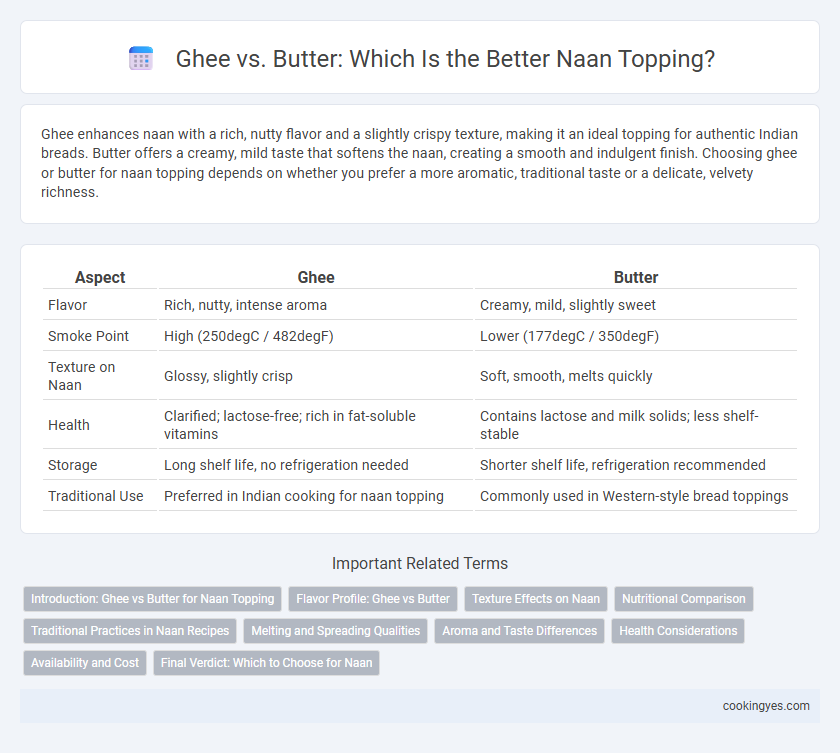Ghee enhances naan with a rich, nutty flavor and a slightly crispy texture, making it an ideal topping for authentic Indian breads. Butter offers a creamy, mild taste that softens the naan, creating a smooth and indulgent finish. Choosing ghee or butter for naan topping depends on whether you prefer a more aromatic, traditional taste or a delicate, velvety richness.
Table of Comparison
| Aspect | Ghee | Butter |
|---|---|---|
| Flavor | Rich, nutty, intense aroma | Creamy, mild, slightly sweet |
| Smoke Point | High (250degC / 482degF) | Lower (177degC / 350degF) |
| Texture on Naan | Glossy, slightly crisp | Soft, smooth, melts quickly |
| Health | Clarified; lactose-free; rich in fat-soluble vitamins | Contains lactose and milk solids; less shelf-stable |
| Storage | Long shelf life, no refrigeration needed | Shorter shelf life, refrigeration recommended |
| Traditional Use | Preferred in Indian cooking for naan topping | Commonly used in Western-style bread toppings |
Introduction: Ghee vs Butter for Naan Topping
Ghee enhances naan with a rich, nutty flavor and a higher smoke point, making it ideal for high-heat cooking and a traditional Indian taste. Butter provides a creamy, mild taste that adds moisture and softness but may burn faster due to lower smoke point. Choosing between ghee and butter influences the texture and authenticity of naan toppings in different culinary styles.
Flavor Profile: Ghee vs Butter
Ghee imparts a rich, nutty flavor to naan, enhancing its aroma with subtle caramelized notes due to the clarified milk solids cooked during preparation. Butter adds a creamy, slightly sweet taste that contributes softness and moisture without overwhelming the bread's natural flavors. The higher smoke point of ghee allows for a toasted finish, creating a more complex and robust flavor profile compared to the delicate and mild taste provided by butter.
Texture Effects on Naan
Ghee topping imparts a rich, nutty flavor to naan while creating a crisp, slightly flaky outer texture due to its higher smoke point and clarified fat content. Butter, with its natural milk solids and moisture, results in a softer, more tender naan surface that remains moist but can become greasy if overapplied. The choice between ghee and butter directly influences the naan's mouthfeel, balancing crispness and softness according to culinary preference.
Nutritional Comparison
Ghee, clarified butter with a higher smoke point, contains more concentrated fats and essential fatty acids such as omega-3 and omega-6 compared to regular butter. Butter offers a richer source of vitamins A, D, E, and K2, but has more lactose and milk solids, making it less suitable for lactose-intolerant individuals. Choosing ghee for naan topping provides a nutrient-dense alternative with enhanced digestibility and longer shelf life, while butter contributes additional micronutrients and a creamier texture.
Traditional Practices in Naan Recipes
Traditional naan recipes often use ghee as the preferred topping due to its rich aroma and high smoke point, which enhances the bread's texture and flavor. Ghee, clarified from butter, provides a distinctive nutty taste that complements the charred edges of naan baked in a tandoor. Butter is occasionally used, but ghee remains favored in authentic Indian cooking for its ability to retain moisture and impart a deeper, more complex flavor.
Melting and Spreading Qualities
Ghee offers superior melting and spreading qualities for naan topping due to its clarified nature, which allows it to melt evenly without separating or burning. Butter, while rich in flavor, contains milk solids that can cause uneven melting and a tendency to burn at high temperatures, affecting the texture and taste of the naan. Using ghee enhances the naan's softness and imparts a rich, nutty aroma that spreads smoothly across the surface for an authentic finish.
Aroma and Taste Differences
Ghee imparts a rich, nutty aroma to naan, enhancing its traditional Indian flavor profile with subtle caramelized notes. Butter offers a creamy texture and a milder, sweeter taste, which provides a softer, more delicate flavor to the bread. The choice between ghee and butter for naan topping influences the overall sensory experience, with ghee delivering a deeper, more robust aroma while butter yields a smoother, more buttery richness.
Health Considerations
Ghee is a clarified butter rich in healthy fats and antioxidants, offering better digestion and a higher smoke point, which reduces harmful compounds when cooking naan. Butter contains milk solids and water, which can cause naan to become soggy and may lead to lactose intolerance issues for some individuals. Choosing ghee over butter for naan topping supports improved heart health and reduced inflammation due to its concentration of beneficial fatty acids and vitamins.
Availability and Cost
Ghee is widely available in Indian and specialty grocery stores and offers a rich, nutty flavor to naan, but it tends to be more expensive than regular butter. Butter is more commonly found in most supermarkets and is generally more affordable, making it a budget-friendly topping option for naan. Choosing between ghee and butter depends on balancing authentic flavor preferences with accessibility and cost considerations.
Final Verdict: Which to Choose for Naan
Ghee enhances naan with a rich, nutty flavor and higher smoke point, making it ideal for a perfectly crisp and aromatic finish. Butter offers a creamy, slightly sweet taste that enriches naan's softness but may burn faster when exposed to high heat. For authentic texture and deeper flavor, ghee is the preferred topping, while butter suits those seeking a milder, indulgent taste.
Ghee vs Butter for Naan topping Infographic

 cookingyes.com
cookingyes.com